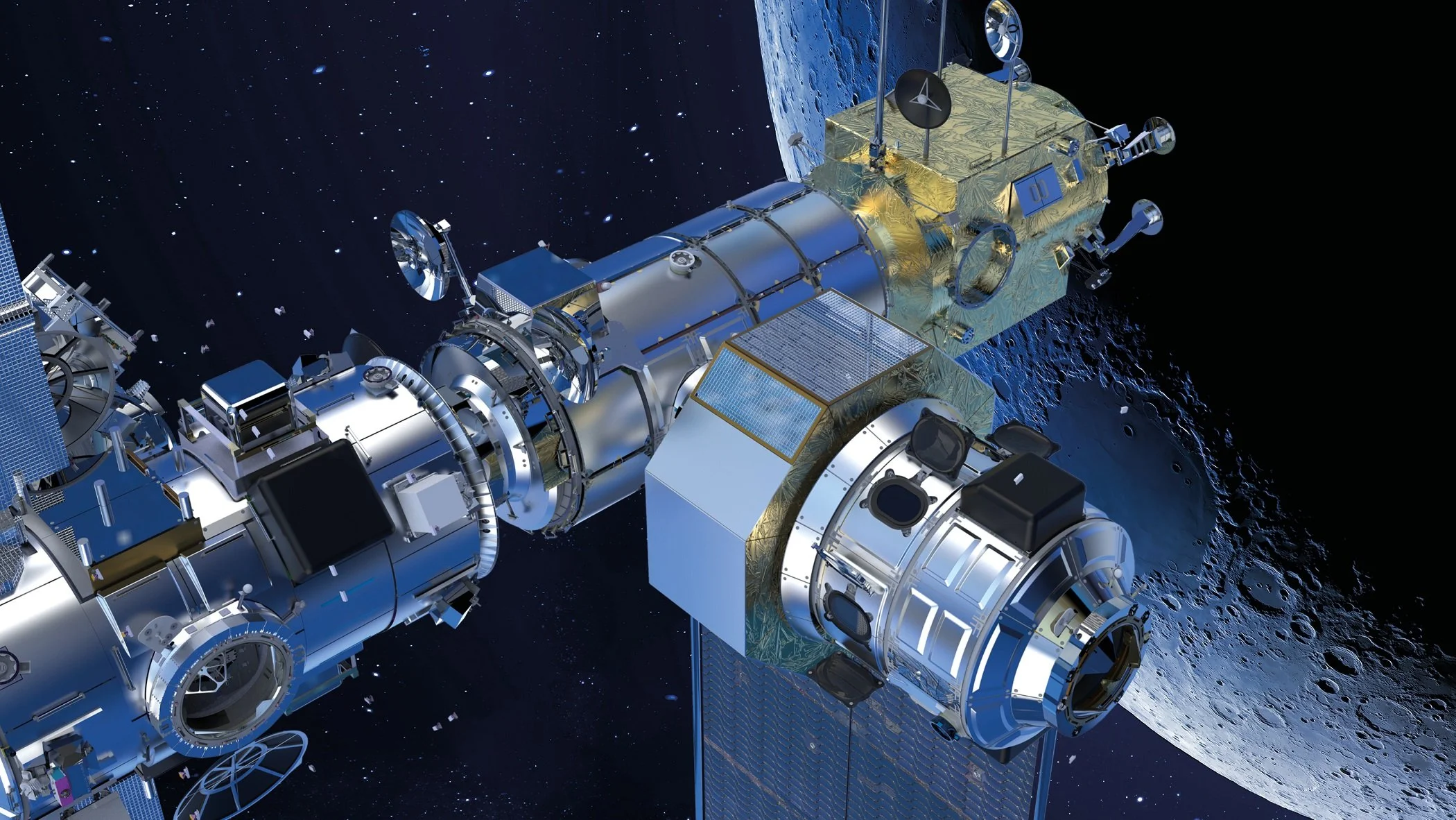ESPRIT Module for Lunar Gateway Orbital Outpost Set for a Significant Upgrade
ESPRIT module on the Gateway ©Thales Alenia Space
Thales Alenia Space, the joint venture between Thales (67%) and Leonardo (33%), has signed an amendment to its contract with the European Space Agency (ESA) to develop the ESPRIT[1] communications and refueling module for the future Lunar Gateway orbital outpost. Worth €164 million, the amendment provides for extending and optimizing the ESPRIT module for which Thales Alenia Space in France is the prime contractor, in collaboration with OHB, alongside Thales Alenia Space in Italy and in the UK.
The ESPRIT module is composed of two main elements: Lunar Link[2] will ensure communications between the Gateway and the Moon, while Lunar View[3] will supply the station with xenon and chemical propellants to extend its lifetime. Lunar View features a pressurized volume with six large windows, offering a 360° view on the outside of the Gateway and the Moon, and will include a logistics area for storing cargo and supplies intended for the crew.
This amendment to the ESPRIT contract provides for a significant increase in the size of Lunar View, which will now span 4.6 meters and be 6.4 meters long, with a total mass of 10 metric tons (versus 3.4 meters, 3 meters and 6 metric tons initially). This evolution is the result of NASA’s choice to launch Lunar View alongside a crewed Orion vehicle aboard the SLS Block 1B launcher, which offers more lift capacity than the launch vehicle previously planned.
In particular, the extended Lunar View will:
Provide more storage space (6.5 m3) on-orbit and accommodate up to 1.5 metric tons of cargo at launch, thus reducing resupply flights to the Lunar Gateway;
Enable installation of two attachment points to accommodate the Canadarm3 mobile robotic arm system, supplied by the Canadian Space Agency (CSA), for operations such as inspecting, maintaining or repairing the Gateway, assisting astronauts during spacewalks, handling science experiments in lunar orbit, or catching spacecraft visiting the Gateway;
House the avionics suite equipment (computer, etc.) inside the module for easier maintenance and to avoid extravehicular activities if repairs are required.
These upgrades will require all of Lunar View’s subsystems to be adapted, especially the electrical power and avionics subsystems and the software and crew interface equipment.
Lunar Link is scheduled to launch in 2026 with the HALO module, while Lunar View is planned for delivery in 2029 for launch a year later, on the Artemis V mission.
“I would like to thank ESA for supporting our industry and renewing its trust in our company’s expertise,” said Hervé Derrey, CEO of Thales Alenia Space. “Thanks to the perfect complementarity of our competences in Italy and in France, we are proud to be contributing our know-how to the Artemis program and to the Lunar Gateway orbital outpost, which are set to push the boundaries of lunar exploration and pave the way for future crewed deep-space exploration missions, with Mars in sight.”
This contract consolidates Thales Alenia Space’s key role in crewed and robotic exploration of the Moon and deep space. The company is supplying critical systems for the Orion capsule’s European Service Module (ESM) and is currently developing two more pressurized modules for the Lunar Gateway: the Lunar International Habitat module (I-HAB) for ESA and the Habitation and Logistics Outpost (HALO) for Northrop Grumman. Thales Alenia Space has also signed a major contract with the Italian space agency ASI to launch the project to build the very first lunar Multi-Purpose Habitat (MPH).
Industrial contributions to the ESPRIT module
Thales Alenia Space in France is the program prime contractor. Thales Alenia Space in Italy is supplying the pressurized tunnel and windows and Thales Alenia Space in the UK is contributing to the chemical propellant refueling system, while OHB – as a main team member – is in charge of the mechanical and thermal subsystems for the non-pressurized parts of the module and the xenon refueling system. Thales Alenia Space in Belgium was selected after competitive bidding to supply the Remote Interface & Distribution Unit for Lunar Link and the Traveling Wave Tube Amplifiers. Thales Alenia Space in Spain will develop the S-band communication transponder and Thales Alenia Space in Italy the K-band transponder.
A cislunar orbital station
The Lunar Gateway orbital outpost is one of the pillars of NASA’s Artemis program to establish a sustained human presence on the Moon as a staging post for future interplanetary exploration missions. This program is an international collaboration between NASA (United States), ESA (Europe), JAXA (Japan) and CSA (Canada). The 40-metric-ton station will be assembled in space and placed in an elliptical lunar orbit. It will be equipped with a robotic arm and docking ports, and made up of habitation modules to accommodate long-duration crewed missions and provide electrical power, propulsion, logistics and communications. While not designed to be manned permanently, it will be able to support up to four astronauts for one to three months. Acquiring new experience on and around the Moon will prepare NASA to send the first humans to Mars in the years ahead, and the Lunar Gateway is set to play a vital role in this endeavor.
[1] European System Providing Refueling, Infrastructure and Telecommunications
[2] Previously HLCS (HALO Lunar Communication System)
[3] Previously ERM (ESPRIT Refueling Module)
